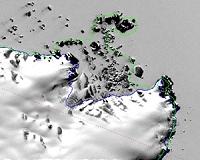 |
Paris, France (ESA) Jul 27, 2010 Researchers using the four spacecraft of ESA's Cluster mission have uncovered the long journey that energetic ions undergo during geomagnetic storms and how they ultimately precipitate into the Earth's atmosphere. Such precipitation affects the composition of the ionosphere, preventing GPS and communications satellites from operating correctly. The Earth's magnetic field acts a buffer zone, shielding the Earth from the permanent flow of ionised matter coming from the Sun. As a result of the interaction of the solar wind with the Earth's field, a protective bubble known as the magnetosphere is formed. This comprises a complex mixture of electric and magnetic fields, charged particles and resultant current systems. One such system, the so-called Ring current, forms in a doughnut shape around the Earth, and is caused by trapped particles, from either the solar wind or from the Earth's ionosphere, gyrating around the magnetic field lines of the Earth. Changes in the ring current are responsible for global decreases in the Earth's surface magnetic field. During periods of quiet geomagnetic activity, the ring current is carried by protons (H+ ions) from the solar wind. During geomagnetic storms an abundance of oxygen ions (O+) is observed, which come from the ionosphere. However, it has not been clear up to now how this O+ gets there. In a recently published paper, Lynn Kistler (University of New Hampshire, USA) and her colleagues have used Cluster data to present a detailed picture of the journey these ions make to get to the ring current. The journey takes the ions flowing out of the ionosphere from the polar regions or cusps of the Earth's magnetic field during storm periods, then into the tear-drop shaped magnetic tail of the magnetosphere where they are energised and eventually injected into the ring current, resulting in the observed abundance. "There are O+ ions out-flowing constantly from the atmosphere but during a geomagnetic storm the outflow is much more intense," Kistler says. "This is a tracer of a geomagnetic storm; if you have much more oxygen out-flowing then this is a clear indication that there is a storm on-going," she added. The effect of this increased abundance of O+ on the ring current is to completely alter the manner in which it interacts with the local magnetosphere. One such effect is to enhance the occurrence and intensity of electromagnetic waves which interact with the ions. This so-called wave particle interaction has been the focus of another Cluster study led by Zhigang Yuan of Wuhan University in China, which has confirmed a long standing result based on computer simulations. In such an interaction, the waves scatter the particles out of the ring current and into the atmosphere to disperse the storm-enhanced ring current. In the study, Cluster instruments identified the waves while the resultant precipitation, near the Earth's auroral regions, was captured simultaneously by the NASA IMAGE satellite. When such an event occurs the ions interact with the Earth's atmosphere and alter its physical characteristics. "If there are a lot of ions precipitating down then it can change the conductivity of the ionosphere," explains Yuan. This has a profound effect on GPS and satellite communication as it extends the signal travel time through the ionosphere, leading to positioning errors. A better understanding of this space weather phenomenon can allow the effect to be taken into account and help minimise the effect geomagnetic activity has on our technology-dependent society. "The Cluster mission is a major contribution of ESA to the International Living with a Star programme. This programme is a collaboration of the world-wide scientific community to understand the science behind space weather. With 10 years of operations - and still going strong - Cluster will provide the first set of multipoint measurements in the Earth's magnetic environment over a full solar cycle," comments Philippe Escoubet, ESA Cluster Mission Manager. "This is a unique contribution to our ability to model and to understand space weather."
Share This Article With Planet Earth
Related Links Cluster Earth Observation News - Suppiliers, Technology and Application
 Antarctica Traced From Space
Antarctica Traced From SpaceWashington DC (SPX) Jul 26, 2010 Antarctica may not be the world's largest landmass - it's the fifth-largest continent - but resting on top of that land is the world's largest ice sheet. That ice holds more than 60 percent of Earth's fresh water and carries the potential to significantly raise sea level. The continent is losing ice to the sea, and scientists want to know how much. Antarctica's ice generally flows from the ... read more |
|
| The content herein, unless otherwise known to be public domain, are Copyright 1995-2010 - SpaceDaily. AFP and UPI Wire Stories are copyright Agence France-Presse and United Press International. ESA Portal Reports are copyright European Space Agency. All NASA sourced material is public domain. Additional copyrights may apply in whole or part to other bona fide parties. Advertising does not imply endorsement,agreement or approval of any opinions, statements or information provided by SpaceDaily on any Web page published or hosted by SpaceDaily. Privacy Statement |